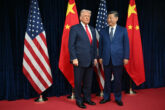February 14, 2022
It’s Not Just 5G: China’s Telecom Strategy Needs to Be Countered in Space
Over the last five years, the security implications of China’s 5G proliferation have received a steady amount of attention. But there is a lesser-discussed, increasingly important side of technological competition between the US and China: Beijing’s growing involvement in the many other critical components and technologies that power the future of global telecommunications, from the depths of the oceans to outer space.
Advanced technologies that will ride on top of 5G networks — such as robotics, drones, autonomous vehicles, augmented reality/virtual reality (AR/VR) and video surveillance cameras — could prove vulnerable. But so too can backhaul, subsea cables, mobile applications, and mobile devices that all contribute to the global telecommunications network. China has increased state investment in these areas, with an eye on controlling the networks that data is transported on and, potentially, access that critical data.
The Biden administration needs to look up to space to provide a counter for China’s telecommunications plan.
China is approaching these with the same stance they have taken towards 5G — that domination is needed across the board. And unlike America, where the various communications technology sectors tend to run parallel but separate, China is seeking to intertwine everything, an important strategy that could give them a leg up on the US unless Washington can switch its thinking and take countering actions.
The good news: it’s not too late to take action, and in one crucial domain, the US still has dominance. As previously disassociated technologies begin to overlap, 5G applications through the space domain will be the connective tissue. Washington must prepare for this new frontier of technological competition by taking several steps to change the current thinking.
Read the full article from Breaking Defense.
More from CNAS
-
Indo-Pacific Security / Technology & National Security
CNAS Insights | The Cost of Silence on China’s Cyber AggressionJust weeks before the much anticipated meeting between President Donald Trump and General Secretary Xi Jinping, the United States discovered yet another major China-backed cyb...
By Morgan Peirce
-
Defense / Technology & National Security
What to Expect from Military AI in 2030As the US military races to harness artificial intelligence, experts say the biggest AI breakthroughs may not come from “killer robots” or autonomous war machines, but from al...
By Josh Wallin
-
Defense / Indo-Pacific Security / Technology & National Security
To Compete with China on Military AI, U.S. Should Set the StandardsThe United States has an opportunity to lead in global norms and standards for military AI at a critical moment, when the foundations laid today could shape how militaries use...
By Jacob Stokes, Paul Scharre & Josh Wallin
-
Defense / Energy, Economics & Security / Technology & National Security
The Outlook CEO Perspectives on Risk, Resilience and ReturnsJoin David Schwimmer and Richard Fontaine, CEO of the Center for New American Security, as they explore the current national security landscape and its impacts on global econo...
By Richard Fontaine




